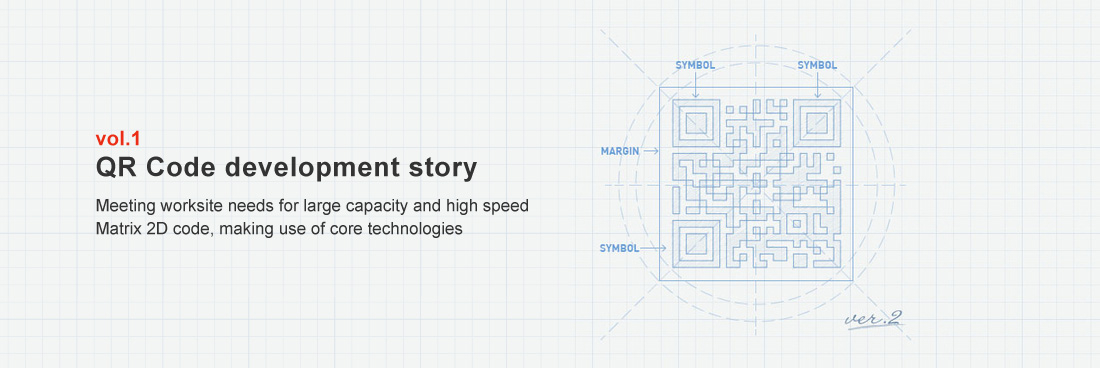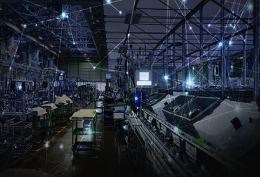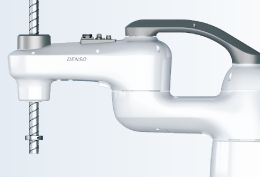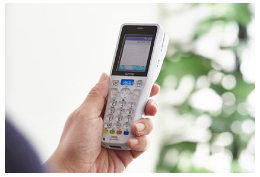

Masahiko Hara
General Manager / Engineering Department 2
Engineering Division 2, AUTO-ID BU
By the 1980s, the barcode system was used in a wide range of fields, including the manufacturing, distribution and retailing industries. Hara says, “In the 1990s, due to a shift from mass manufacturing of one type of product to more flexible production, more detailed production control was required at manufacturing sites, and in association with this, developing a barcode that had increased capacity was required.”
In 1992, Masahiro Hara, who was engaged in the development of barcode scanners and optical character recognition (OCR) devices at Denso, was asked by manufacturing sites to develop barcode scanners that could read barcodes more quickly.
At that time, in the production field the capacity constraint of the barcode system was made up for by using more than one barcodes at the same time. However, since each barcode can store only 20 alphabetic characters or so, workers had to scan as many as approximately 1,000 barcodes per day, making the work less efficient, contrary to what was intended.
Initially, Masahiro Hara tried to respond to the demands from the field by improving barcode scanners; however, he began feeling the limitations of the barcode system. Furthermore, just at that moment, since products were increasingly downsized, creating a code that could be printed in a smaller area was required.
“We will develop a compact code that can store more information, including kanji and kana characters, and at the same time can be read at higher speed.” Hara determined to develop a new code system.

In the case of barcodes, information can be coded only in the transverse direction (one dimension), while in the case of 2D codes, information can be coded in both the transverse and longitudinal directions (two dimensions).
The development team led by Masahiro Hara began to develop a new 2D code system with only two members.
The most challenging problem for the development team was how to make 2D codes read as fast as possible; it is more difficult for scanners to recognize the location of a 2D code than that of a barcode.
One day, Hara hit on the idea of adding, to the code, information that indicates its location, which might solve this problem.
Based on this idea, a position detection pattern, located at three corners of each code, was created. He expected that by incorporating this pattern into a 2D code, a scanner could accurately recognize the code and thereby read it at high speed.
However, developing the shape of the position detection pattern was extremely difficult because when a similarly shaped figure was near the code, the pattern could not be recognized accurately. To prevent false recognition, the position detection pattern had to have a unique shape. The development team members began an exhaustive survey of the ratio of white to black areas in pictures and characters printed on leaflets, magazines, corrugated cartons and other documents after reducing them to patterns with black and white areas. They continued to study numerous printed matter day and night, and at last identified the ratio that least appeared on the printed matter. It was 1:1:3:1:1.
In this way, the widths of the black and white areas in the position detection pattern were determined and scanners became able to detect the code regardless of the scanning angle by finding this unique ratio.
After a year and a half from the start of the development project, as a result of much trial and error, the QR Code system, capable of storing approximately 7,000 figures with the additional capability to code Kanji characters, was successfully developed. This code can store a large quantity of information and at the same time can be read at more than 10 times the speed of other codes.

Two-dimensional codes had existed even before the QR Code system was developed; however, the QR Code system has a unique advantage —— extraordinarily suitable to be used in the field.
First, QR Code are resistant to dirt and damage, which is an advantage in manufacturing sites, which are vulnerable to oil or other dirt. Documents exchanged in manufacturing fields are often stained due to grease and the like. While stained barcodes cannot be read by scanners, QR Code, with an error correction function, can be read accurately even if a code is partially stained/missing.
Next, QR Code are easy to read.
The angles of scanning vary when codes are scanned manually with mobile scanners and codes of parts on manufacturing lines are scanned mechanically. For this reason, to make codes read quickly, the position of each code needs to be recognized accurately.Since each QR code has three position detection patterns, its position can be recognized correctly.

DENSO WAVE has been manufacturing barcode scanners and delivering them to manufacturers and other companies since the beginning of the 1980s. “Until then, we were engaged in developing technologies for barcode recognition, OCR and phonetic recognition. For this reason, we had already accumulated technologies for image processing, decoding and character recognition. This is why we could successfully develop this easy-to-read code,” said Masahiro Hara.
DENSO WAVE has continued developing excellent recognition algorithms based on such know-how to date. This is the prime reason DENSO WAVE's AUTO-ID products have the excellent capabilities of reading QR Code.

QR Code are now being used not only in manufacturing industry, the initially targeted field, but also for various uses, including on tickets and advertisements.
Since launching the QR Code system in 1994, DENSO WAVE has continued evolving it in order to meet social needs. The new QR Code launched includes: the SQRC, which has a data reading restricting function and thereby improved security and the Frame QR, which has a canvas field in the code, enhancing the design of the code.
The QR Code System is still evolving and a combination of QR Code and cloud computing offers new added value —— the “Q-revo.”
The “Q-revo” is a service in which linking the “Q Platform,” a cloud server that generates, distributes, reads and stores data of QR Code and the QR Code Reader “Q,” a smartphone app, enables tracing, authenticity judgment, payment/point/coupon services, entrance/access control, etc.
“We will develop systems utilizing QR Code from the users' point of view,” Atsushi Tano, working for the System Solution Group.
Know-how owned by the manufacturer that developed the QR Code system leads to the next “fulfillment.”

The European Inventor Award has been awarded annually since 2006 by the European Patent Office to inventors and inventor groups of technologically, socially and economically excellent inventions. In 2014, the QR Code development team was awarded the Popular Prize (winner selected from among the finalists from votes by the public), receiving a high evaluation because the QR Code was widely recognized by general consumers in a large number of regions and age groups.


